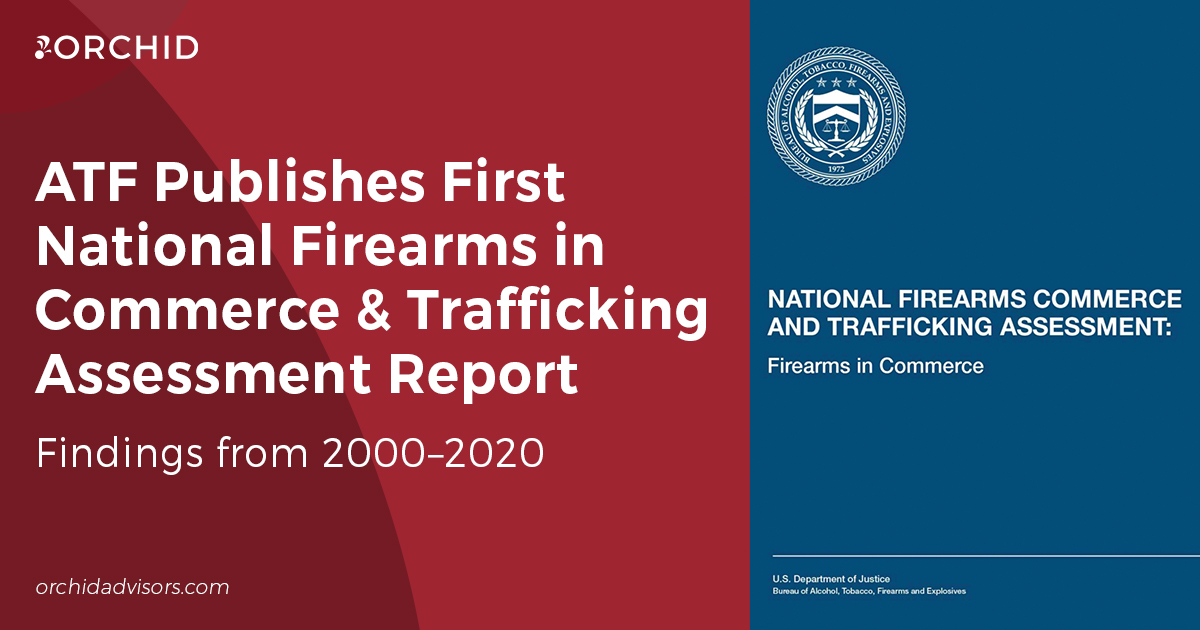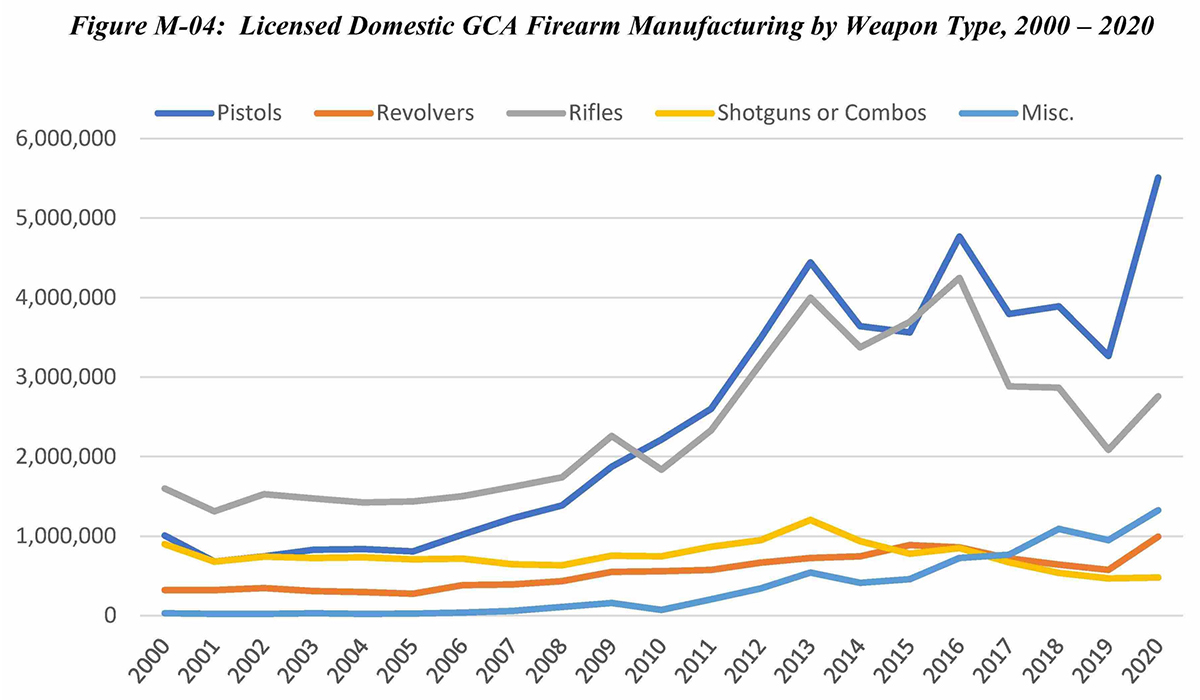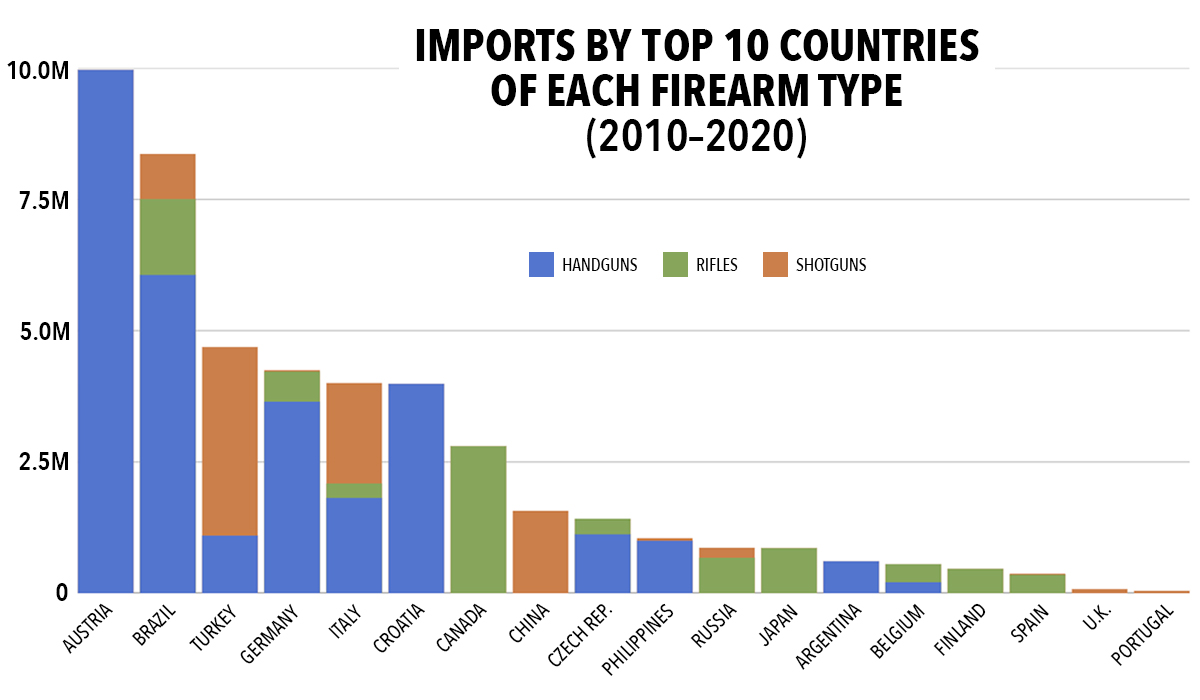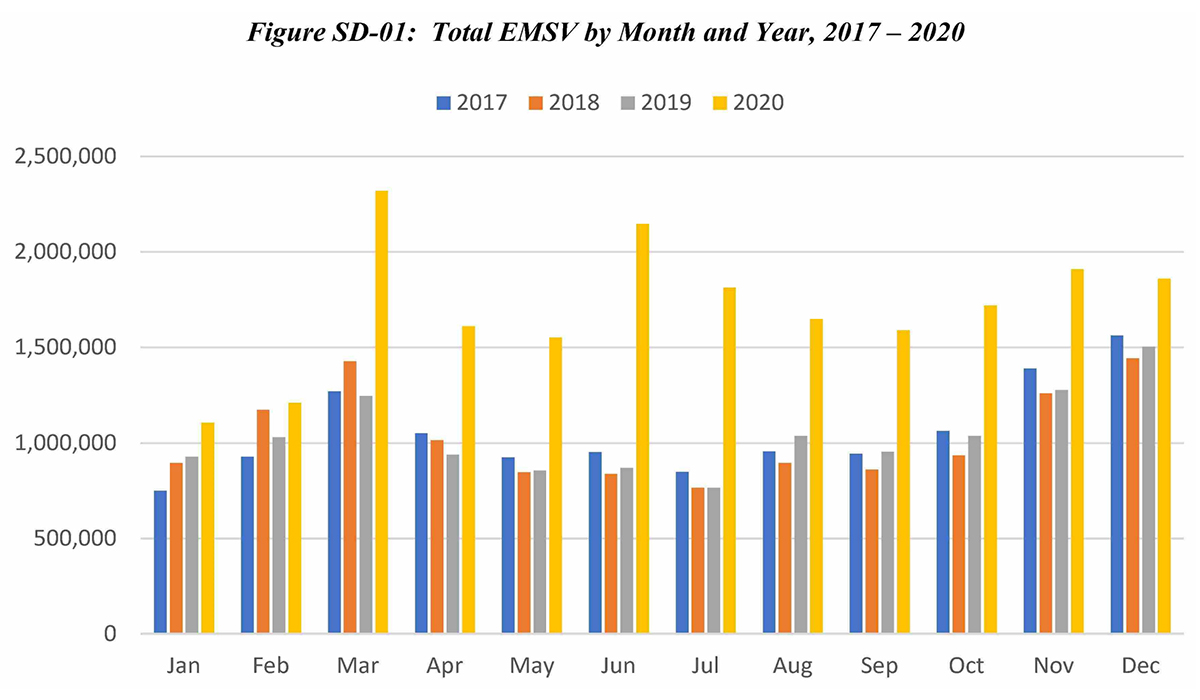Last week, the ATF published the first volume of a comprehensive report examining commerce in firearms and the diversion of firearms to illegal markets, appropriately titled the National Firearms in Commerce and Trafficking Assessment (NFCTA). As part of an administration-wide strategy to combat the rise in violent crime, the ATF assembled a team of subject matter experts within the agency, academia, and other related fields to produce the report at the direction of President Joe Biden and Attorney General Merrick Garland.
While the ATF produces various public and law enforcement reports regarding firearm commerce, trafficking, and related issues every year – including the Firearms Commerce in the U.S. Annual Statistical Update and summaries of U.S. Firearms Trace Data and Firearms Reported Lost and Stolen – it has not undertaken a joint academic study of this scale in more than 20 years. To cover this gap, Volume I provides a broad overview of firearms commerce from the last two decades, though much data analysis is focused on the years 2016 to 2020.
Over 300 pages long, the NFCTA report is much too long to break down in just one article. However, we’ll attempt to summarize its key parts and findings from within each we found most interesting.
Editor’s Note: Unless otherwise stated, statistics reflect data from 2016–2020.
Table of Contents
Part I: Manufacturing of Firearms & Ammunition
Part II: Privately Made Firearms
Part III: Firearms Exported from U.S.
Part IV: Firearms Imported into U.S.
Part V: Selling and Distribution
Part VI: Price of Small Arms and Ammunition
Part VII: National Firearms Act
Part VIII: FFL Inventory Losses
Part IX: Industry Overview
Part X: Industry Regulation
Part I: Manufacturing of Firearms and Ammunition
- Current FFL license fees were established in 1993. If adjusted to current values using the Consumer Price Index (CPI), fees would increase nearly 99%, increasing the cost of Type 01 and 02 licenses from $200 to $400, and Type 07 and 08 licenses from $150 to $300.
- Though required by regulation, not all manufacturers file the Annual Firearms Manufacturing and Exportation Report (AFMER). On average, 30% of licensed manufacturers failed to report an AFMER. However, FFLs responsible for manufacturing most firearms have consistently submitted the AFMER.
GCA & NFA Weapon Manufacturing
- Domestic GCA firearm and NFA weapon manufacturing increased 187% from 2000–2020.
- Between 2010–2020, annual firearm production grew 103%.
- Smith & Wesson, Ruger and SIG SAUER entities collectively manufactured 42% of all manufactured GCA firearms.
- Top 10 manufacturer entities reported producing 70% of all GCA firearms.
- Top 10 GCA firearm manufacturer entities: (1) Smith & Wesson, (2) Ruger, (3) SIG SAUER, (4) Freedom Group, (5) Mossberg, (6) Taurus International Manufacturing, (7) Anderson Manufacturing, (8) GLOCK, (9) Henry Repeating Arms, (10) JJE Capital
- In 2010, pistols became the dominant firearm type manufactured, overtaking rifles (except in 2015).
- Annual rifle production increased 165% between 2000–2016, declining 35% between 2016–2020.
- Annual shotgun manufacturing increased 34% from 2000–2013, declining 60% between 2013–2020.
- Miscellaneous firearm production grew 4,281% between 2000–2020.
- NFA weapon manufacturing increased 199% between 2000–2020. However, NFA firearms make up just 2% of all firearms manufactured.
- Annual silencer manufacturing increased 3,699% between 2000–2020 with the bulk of this growth taking place after 2010.
Graph of GCA firearm manufacturing by weapon type between 2000–2020 (Source: ATF)
Part II: Privately Made Firearms (PMFs)
- At least three factors have can be attributed to the growth of PMFs: (1) the emergence of the internet as a source of information and marketplace to obtain gun products, (2) the emergence of alternatives to metal casting and forging for making firearm parts (e.g., high-strength polymers), and (3) technological and design advancements (e.g., computer software and 3D printing) that allow for “modular” firearm design/manufacture while reducing cost and size of tools needed to make firearms.
- Between 2016–2021, 45,240 suspected PMFs were reported to the ATF as recovered from potential crime scenes, increasing 1,000% from 2016–2021
Part III: Firearms Exported from U.S.
- Total GCA firearms and NFA weapons exported annually increased 240% between 2000–2020.
- SIG SAUER, GLOCK and Ruger collectively exported 59% of total GCA firearms exported.
- Top 10 manufacturers of GCA firearm exports: (1) SIG SAUER, (2) GLOCK, (3) Ruger, (4) Smith & Wesson, (5) Freedom Group, (6) Mossberg, (7) Henry Repeating Arms, (8) Savage Arms, (9) Beretta USA, (10) CZ Group.
- Annual NFA weapon exports grew 667% from 2000–2020.
Graph of firearm imports by top 10 countries for each firearm type between 2010–2020
Part IV: Firearms Imported into U.S.
- Total firearm imports increased 357% between 2000–2020.
- Handguns had steepest growth (440%) of any firearm imported; rifles grew 172%.
- Shotgun imports more than doubled from 2019–2020.
- Annual total ammunition imported grew dramatically, peaking at more than 4.4 billion in 2016.
- Between 2000–2010, ammunition imports increased 102,315%; grew 175,365% between 2000–2020.
Imports by Country of Origin
- Top 10 countries of origin for each firearm type imported more than 96% of handguns, 87% of rifles, and 99% of shotguns between 2010–2020.
- Largest source of handgun imports: Austria (32.7%)
- Largest source of rifle imports: Canada (30.3%)
- Largest source of shotgun imports: Turkey (43.2%)
- Largest source of ammunition imports: Russia (23%)
- Austria, Brazil, Croatia and Germany combined for 78% of all handgun imports between 2010–2020.
- Canada and Brazil imported 46% of all rifles from 2010–2020.
- Turkey, Italy, China and Brazil imported 95% of all shotguns between 2010–2020.
- Brazil was the only country of origin in the top five of each firearm type from 2010-2020; 19.9% of handguns (2nd), 15.8% of rifles (2nd), and 10.3% of shotguns (4th).
- Russia, Italy, Mexico and South Korea imported 57% of all ammunition and ammunition components between 2010-2020.
Graph of Estimated Minimum Sales Volume of FFLs by month and year between 2017–2020 (Source: ATF NFCTA)
Part V: Selling and Distribution
National and State EMSV Trends
- Estimated Minimum Sales Volume (EMSV) is used to estimate aggregate firearm sales conducted by FFLs; calculated by multiplying number of NICS checks conducted by the number of distinct NICS purpose codes associated with a NICS transaction that involved actual transfer of a firearm.
- From 2017–2020, Type 01 and Type 02 FFLs accounted for 90% of all EMSV, while Type 07 FFLs accounted for 10%.
- Between 2017–2020, approximately 85% of Type 01 FFLs had less than 500 EMSV, representing just 8% of total Type 01 EMSV.
- Less than 3% of Type 01 FFLs conducted nearly 58% of all firearms sales from 2017–2020.
- Highest EMSV months between 2017–2020 were December (11%), March (10.8%) and November (10.1%).
- Nine of the top 10 highest EMSV months from 2017–2020 occurred in 2020.
- Highest EMSV state: Texas (8.4%)
- Top 10 states in EMSV from 2017–2020 combined for 48.5% of total EMSV.
- Top 10 states in total EMSV: (1) Texas, (2) Florida, (3) California, (4) Pennsylvania, (5) Ohio, (6) Virginia, (7) Tennessee, (8) Missouri, (9) Indiana, (10) Washington.
Multiple Sale Reports (MSRs)
- FFLs reported over 2.5 million multiple sale transactions representing 5.8 million firearms from 2016–2020, an average of 2.3 firearms per MSR.
- Pistols and revolvers accounted for 98% of all firearms reported in MSRs.
- Top 10 firearms associated with MSRs from 2016–2020 were pistols or revolvers from GLOCK, Heritage Mfg., Ruger, SIG SAUER, Smith & Wesson and Taurus.
Part VI: Price of Small Arms & Ammunition
- Price of small arms rose 31%, while price of small arms ammunition grew 145% from 2000–2020. Comparatively, price of consumer goods increased 52% during this period.
Graph of NFA applications and ATF examiners per year between 2010–2020 (Source: ATF NFCTA)
Part VII: National Firearms Act (NFA)
NFA Applications
- Annual NFA applications increased 1,231% between 2000–2020.
- ATF Forms 3 and 4 account for the largest share of NFA applications received on an annual basis.
- Over 10 million NFA weapons were associated with more than 2 million NFA applications received between 2016–2020, of which 42% were for silencers and 39% for destructive devices.
- ATF processed 2,012,836 NFA applications from 2016–2020, comprised of 64% paper applications and 36% eForms.
- From 2013–2020, annual ATF eForm applications grew 38%.
- Since 2000, ATF has processed and approved an average of 95% of correctly submitted NFA applications received annually.
- From 2010-2020, 41 or fewer ATF examiners were responsible for processing NFA applications.
- In 2020, 41 examiners were responsible for 551,074 NFA applications, or 13,441 applications per examiner.
- In 2020, the average number of days to process an approved NFA eForm application was roughly 8 days, compared to 154 days to process a paper form.
Special Occupational Taxpayers (SOT)
- Annual total of SOT holders increased 65%.
- Between 2016-2020, total Class 1 SOT payers (importers) increased 12%, Class 2 payers (manufacturers) grew 39%, and Class 3 SOT payers (dealers) rose 90%.
- From 2016–2020, FFLs paid over $30 million in SOT.
Part VIII: FFL Inventory Losses
- Reported FFL inventory losses occur more frequently than all reported thefts (burglaries, robberies, and larcenies) from FFLs.
- FFLs reported 5,766 theft incidents involving 39,147 firearms; FFL inventory losses made up 51% of these incidents and 54% of total firearms.
- Firearms reported missing decreased 57% from 2017–2020.
- Type 01, 02 and 07 FFLs combined for 94% of all incidents and 92% of all missing firearms.
- Type 01 FFLs accounted for 52% of all loss incidents and 57% of all missing firearms during this period, or 8.3 firearms per incident.
- Average of 5% of all FFLs reported a loss incident; 19% of FFLs reported multiple loss incidents.
- Rifles and pistols accounted for 62% of missing firearms reported lost. Of all firearm types, one (1) tear gas launcher was reported missing.
- Only 2.6% of firearms reported missing by FFLs between 2016–2020 have been recovered.
Graph of FFL population by FFL Type between 2000–2020 (Source: ATF NFCTA)
Part IX: Industry Overview
- Between 2000–2020, total FFL population grew nearly 22%.
- Most FFL Types increased during this time, including Type 03 (146%), Type 07 (694%), Type 08 (51%), Type 09 (914%), Type 10 (213%) and Type 11 (290%).
- However, FFL Types 01 (-25%), 02 (-39%) and 06 (-10%) decreased during this period.
- Between 2000–2020, 295,426 new FFLs were issued and 257,652 FFLs were discontinued, creating an overall net gain of just 37,774 FFLs, or 36 licensees per week.
- Top 10 states in FFL population change between 2000–2020: (1) Washington, D.C., (2) Rhode Island, (3) Massachusetts, (4) Maryland, (5) Utah, (6) South Carolina, (7) Arizona, (8) New Hampshire, (9) Delaware, (10) Colorado.
- Top 10 states in FFL population combine for 44.6% of all FFLs.
- Top 10 states in FFL population in 2020: (1) Texas, (2) California, (3) Florida, (4) Pennsylvania, (5) Illinois, (6) North Carolina, (7) Ohio, (8) Missouri, (9) Virginia, (10) Massachusetts.
Graph of ATF inspection violations by FFL Types 01, 02 & 07 between 2016–2020
Part X: Industry Regulation
Regulatory Activities
- ATF IOI staffing between 2016–2020 averaged 641 Field IOIs and 114 Supervisory/Programmatic IOIs.
- As of October 1, 2021, ATF employed 774 IOIs, 646 of which were responsible for conducting firearm and explosives regulatory inspections.
- Between 2016–2020, 97% of ATF industry operations investigator (IOI) activities consisted of firearm or explosive qualification and compliance inspections.
- ATF approved 79% of qualification inspections completed.
- ATF completed 48,445 firearm compliance inspections and 18,385 explosive compliance inspections, a total of 66,830 compliance inspections.
FFL Compliance Inspections
- Due to the 2020 COVID-19 pandemic, ATF pivoted from in-person inspections to telephonic outreach, conducting 5,039 FFL compliance inspections and 14,888 telephonic outreach inspections.
- Between 2016–2020, 64% of all compliance inspections were of Type 01 FFLs.
- No violations were cited in 48.3% of all FFL inspections.
- Over 67.6 million violations were cited during FFL inspections between 2016-2020, including inspections with more than 50,000 violations.
- Top 10 violations cited during inspections (excluding skewed violations):
- Failure to timely, accurately, and completely record information in A&D record
- Failure to timely record firearms manufactured/acquired in A&D record
- Failure to maintain timely, accurate and complete disposition record
- Failure to complete ATF Form 4473 as indicated by form headings and instructions
- Failure to obtain complete purchaser information on 4473
- Failure to file ATF Form 2 for registration of manufactured NFA firearms
- Failure to obtain required license to engage in the business of firearms
- Failure to record all required NICS information (e.g., dates NICS was contacted and response was received)
- Failure to properly mark firearms with manufacturer city and state
- Failure by transferor to sign and/or date (certify) 4473
Parts XI and XIII
Part XI reviews some of the most significant legal and regulatory developments since 2000, while Part XII offers several policy recommendations to improve ATF’s regulatory and enforcement capabilities made by report researchers independent of ATF.
Stay tuned for deeper dives into subjects of the new NFCTA and more ATF updates with the latest firearms industry news for FFLs from Orchid.












![2024 ATF FFL Inspection Violations [Published March 2025]](https://orchidadvisors.com/wp-content/uploads/2025/06/June-16-Blog-Post-ATF.png)
0 Comments